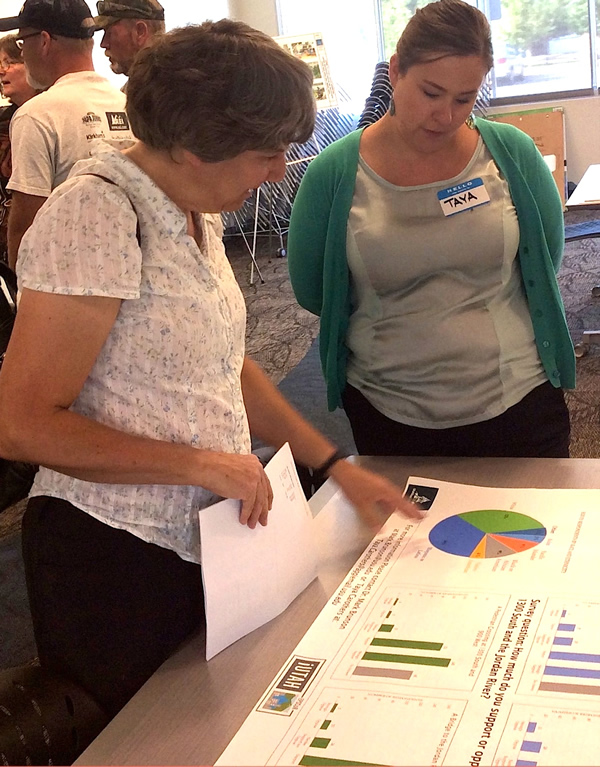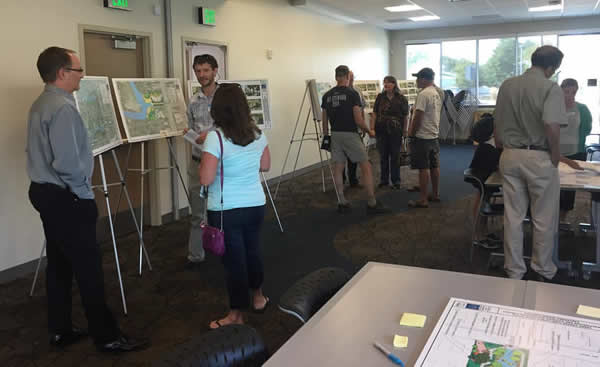iFellows News
March 8, 2017
iUTAH Students Present At Undergraduate Research Conference
Undergraduate students from across the state, including 16 students working on iUTAH research, were selected to present posters/presentations at the 2017 Utah Conference on Undergraduate Research (UCUR) on Friday, February 17, at Utah Valley University in Orem UT.
Students from Southern Utah University, University of Utah, Utah Valley University, and Westminster College presented iUTAH research, in collaboration with faculty Research Catalyst Grants and the iUTAH iFellows undergraduate research experience. For many students, like SUU senior, Hailey Wallace, this was their first UCUR conference. Wallace worked with mentors from SUU and UU, and other students testing the ability of green roofs to contribute to urban invertebrate biodiversity.
“It has been an amazing experience to be a part of undergraduate research," said Wallace. “I am very grateful have been involved in this project since the beginning, and been able to have multiple projects of my own stemming from the main work, as well as present the research at multiple venues.”
Wallace plans to use what she learned and continue her education as a graduate student in the Environmental Science and Management program at Portland State University in the fall. Below are topics and students presenting at UCUR:
Effect Of Phragmites Australis Control On Utah Lake Water Quality
Student(s): Arthur Evensen, Joshua Jackson, Jake Wood, Paul Morris, Ibrihim Alhassan, Kyle Fordham, and Victor Sanjinez (UVU)
Mentor(s): Eddy L Cadet
A Comparative Analysis On Attitudes Toward Drinking Water Quality Between Utah And The Nation
Student(s): Adam James Whalen (2016 iUTAH iFellow), and Meaghan McKasy (UU)
Mentor(s): Sara Yeo
Quantifying Nutrient And Trace Metal Input To Utah Lake From Orem Wastewater Treatment Effluent
Student(s): Sydney Hoopes and Serena Smith (UVU)
Mentor(s): Weihong Wang, and Eddy Cadet
Use Of Green Infrastructure to Increase Invertebrate Biodiversity In The Built Environment
Student(s): Hailey Wallace and Andrew Carlson (SUU)
Mentor(s): Jacqualine Grant, Matthew Weeg, Youcan Feng, and Steven Burian
Effect Of The Disappearance Of The Deep Brine Layer On Trace Element Uptake Into Great Salt Lake Food Webs
Student(s): Madelene Trentman, Abby Scott, and Alexandria Martin (Westminster College)
Mentor(s): Frank Black
Methylmercury In The Great Salt Lake
Student(s): Alexandria Martin (Westminster College)
Mentor(s): Frank Black
UCUR was created to showcase the best undergraduate work from students across the state of Utah. Undergraduates from all disciplines are invited to apply for the conference. Submissions to UCUR 2018, which held at SUU, will be due in the fall. For more information, visit www.ucur.org.
Press: UVU Press Release
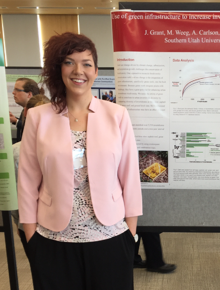
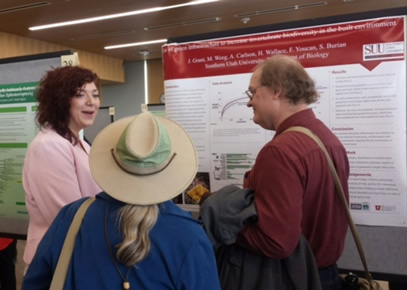
February 23, 2017
Student Research on Utah Water Voices Survey Published
iUTAH undergraduate student researchers Phillip André Valle from Weber State University and Zack Oldroyd from Utah State University, along with sociology professor Courtney Flint and colleagues from USU, featured their work with the Utah Water Voices survey conducted in summer 2015 in a recently released paper. A summary analysis of the study has been published in the Journal of Rural Social Science.
Both Valle and Oldroyd were part of the iFellows program, a research experience for undergraduates focused on iUTAH water projects in the state. The paper and project highlighted public water perspectives in parks in two Utah cities using an interactive form on iPad tablets to guide paperless interviews, which were also audio recorded. More information and audio samples can be found at Utah Water Voices.
The abstract of the paper states that the “undergraduate research assistants played key roles in carrying out this intercept survey project, highlighting potential for future application of this method with students, community groups, or citizen scientists.”
In addition to this paper on “Public Intercept Interviews And Surveys For Gathering Place-Based Perceptions: Observations From Community Water Research In Utah,” the publication includes Carla Trentelman’s research on “The Case for Personal Interaction: Drop-Off/Pick-Up Methodology for Survey Research,” and “Effectiveness of the Drop-Off/Pick-Up Survey Methodology in Different Neighborhood Types,” by Doug Jackson-Smith, Courtney Flint, Carla Trentelman, Grant Holyoak and others.
Journal Reference: Journal of Rural Social Science
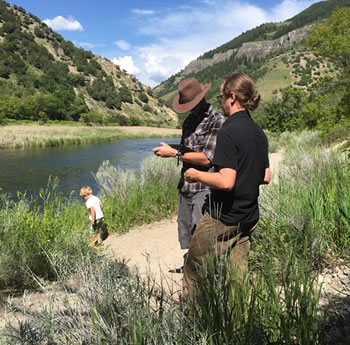
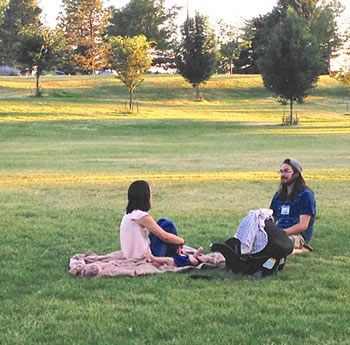
February 6, 2017
iUTAH Students Present Research on Capitol Hill
Undergraduate students from the University of Utah and Utah State University presented their research for Utah lawmakers in the rotunda of the state Capitol in Salt Lake City on Tuesday, Jan. 24, 2017. Due to weather-related issues, USU did not make it down for the event, and will showcase their work at a later date. Two iUTAH students were selected to present research:
Hyrum Tennant, USU student & iUTAH trainee, (mentor Beth Neilson)
Project title: Groundwater Influences on the Logan River Watershed
Adam Whalen, UU student & 2016 iUTAH iFellow (mentor Sara Yeo)
Project title: A Comparative Analysis of Attitudes Toward Drinking Water Between Utah and the Nation
The iUTAH project involves students in a wide range of academic disciplines all related to water research in the state. While participating in research, students learn valuable skills on poster development and engaging in one-on-one and group presentations. As a double major in Communication and Political Science, Adam Whalen said he was especially “excited about how involvement with research can have real world implications in government, and by extension, society,” adding that “this presentation was a wonderful hybrid of my academic interests."
“Capitol Hill also proved to be a fantastic venue, it had an aura of importance and historicity that made me feel like I was a part of something greater for the state of Utah,” said Whalen. “It one of the best experiences in my undergraduate career. It sparked the same creative drive I had during my time as an iFellow, and reminded me of why I got started in research in the first place.”
More information on the event and participants is available in the articles listed below.
Press: UU News | Utah State Today | Deseret News | Daily Utah Chronicle
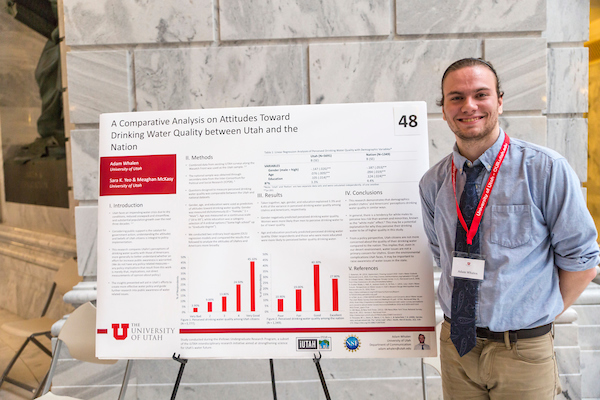
Credit: UU Office of Undergraduate Research
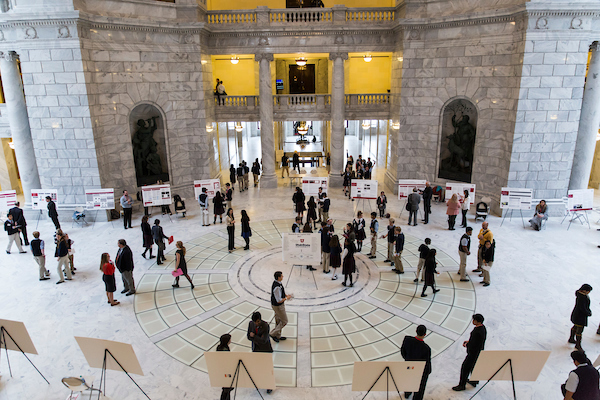
December 9, 2016
WSU Students Present Undergraduate Research
A mini-symposium was held for the fourth straight year on the campus of Weber State University. It featured research posters and presentations from iUTAH’s Summer Institute and the Undergraduate Research Fellows (iFellows) Program. The event was co-hosted by Carla Trentelman, associate professor of Sociology, and Dan Bedford, professor of Geography and WSU honors program director, and attended by students, faculty, administrators, and friends of iUTAH
“The Weber State iUTAH team, and this is very much a team effort, has felt from the beginning that it was important to give our iUTAH students the chance to share their experiences with the WSU community more broadly,” said Bedford. “We’ve had great representation from excellent students in all four years of the iFellows and Summer Institute programs, and it's good for everyone to see what excellent research our students were engaged in.”
Faculty mentors also use the event as a recruitment tool, reminding all in attendance to start thinking about upcoming summer iFellows program, which students may apply for starting in January 2017. Students who attended this program included 2015 iFellow André Valle; Andrew Hackett and Cynthia Elliott, 2016 iFellows; and William Soule and Maggie England, representing two of the five 2016 Summer Institute peer mentors.
“The iUTAH collaboration has provided great opportunities for our faculty and students to engage in research and scholarship related to water resource management in the state, said Charles "Chuck" A. Wight, president of WSU. “I'm grateful to the faculty at Weber State, Utah State University and the University of Utah for their roles in mentoring our students while carrying out the research and in preparing their work for publication and presentation.”
It is always an enriching experience to visit our partner institutions and see what the students have learned and gained on reflection, after returning to their schools in the fall.
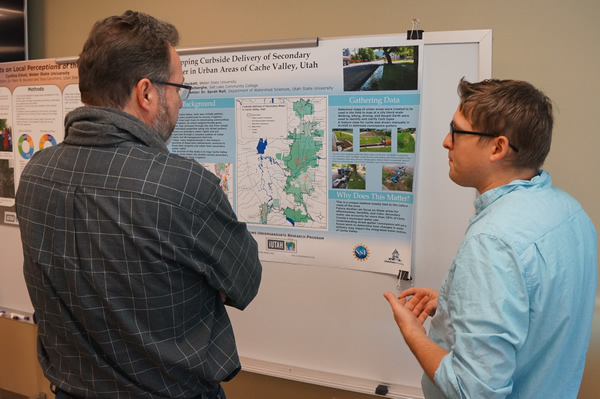
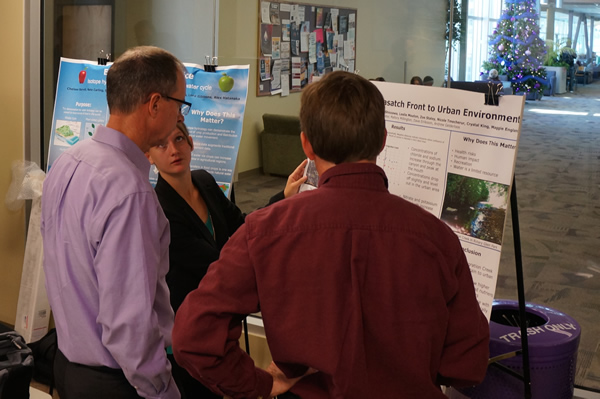
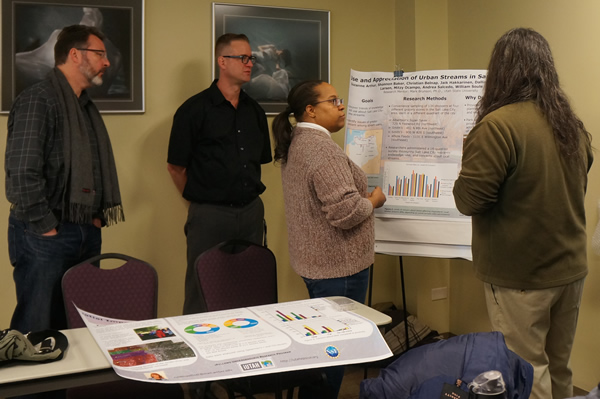
December 6, 2016
Engaging Neighborhoods in Survey Results
Last summer, nearly 400 people on Salt Lake City’s west side were asked about their connections to the Jordan River and the parklands alongside the river. Bilingual surveys were distributed in public places such as grocery stores, libraries, parks, and community events. Students involved in iUTAH Undergraduate Research Fellows (iFellows) Program, Cynthia Elliott and Luis Vidal, conducted the survey using iPads and interacting directly with residents.
Mark Brunson, professor in Utah State University’s Department of Environment and Society and the USU Ecology Center, and Taya Carothers, PhD student at USU, jointly developed the survey. They were aided in this process by collaborators in Salt Lake City’s open space lands program, Lewis Kogan and Tyler Murdock; and the design consultant for the Three Creeks Confluence project.
“As iUTAH’s director of education, outreach, and diversity, I have long wanted to do something that engaged the diverse neighborhoods on Salt Lake City’s west side and could be used to benefit people in those communities,” said Brunson. The idea for the study started at meeting led by Brian Tonetti, the executive director of the Seven Canyons Trust, held in fall 2015. While talking about how the Glendale neighborhood felt about daylighting (freeing buried rivers and streams) that currently run through Salt Lake City, it became clear that getting input from a broad diversity of neighborhood residents was challenging. This seemed like an opportunity to combine Carothers’s research on environmental justice and water with more general questions that might serve a variety of community projects in the area, such as the Glendale project.
After the survey results were collected and data formulated, iUTAH’s cyberinfrastructure team used visualization tools to help make the information accessible and easy to understand. This online tool, the survey data viewer, is publicly available and provides a simple interface to communicate the results of surveys to stakeholders, participants, and the general public. Information on this process can be found here. This information has been useful in presentations to make the results more interesting and applicable to specific groups.
“We found it to be extremely helpful because it is very visual,” said Carothers, who is also an iUTAH Graduate Research Assistant. “As a visual representation, it shows people what the data look like, by the size of the circle as a heat map, and then people can really visualize support or concern about a specific topic.“ It has been used in meetings with neighborhood council groups to show the data and to answer questions. This audience often lacks background information about the survey and mainly wants to know how it relates to them personally. The data viewer allows the presenter to look up answers to the specific area-related questions that people have, and use it as a tool to start a discussion.
“As a researcher who studies human-environment interactions, it’s been fascinating to learn about the different ways that individuals are connected to the Jordan, a very urban river that has a reputation more for impaired water quality than for recreation opportunities,” said Brunson. The link to the data survey has also been sent to specific stakeholders for use in proposal writing for future grants and research. The weed puncture vine, a plant covered with spines sharp enough to flatten bicycle tires, was identified by SLC residents as one of their larger concerns along the river and parkway. In response to this concern, the Open Space Lands program, Natural History Museum of Utah, and Brunson are collaborating on a proposal that could lead to a new citizen science project to address this issue directly.
This project demonstrates the multi-dimensional collaborations and partnerships that iUTAH, an interdisciplinary research and training program aimed at strengthening science for Utah’s water future, fosters in the state.
For downloadable article, along with quick reads version, visit the full article…
